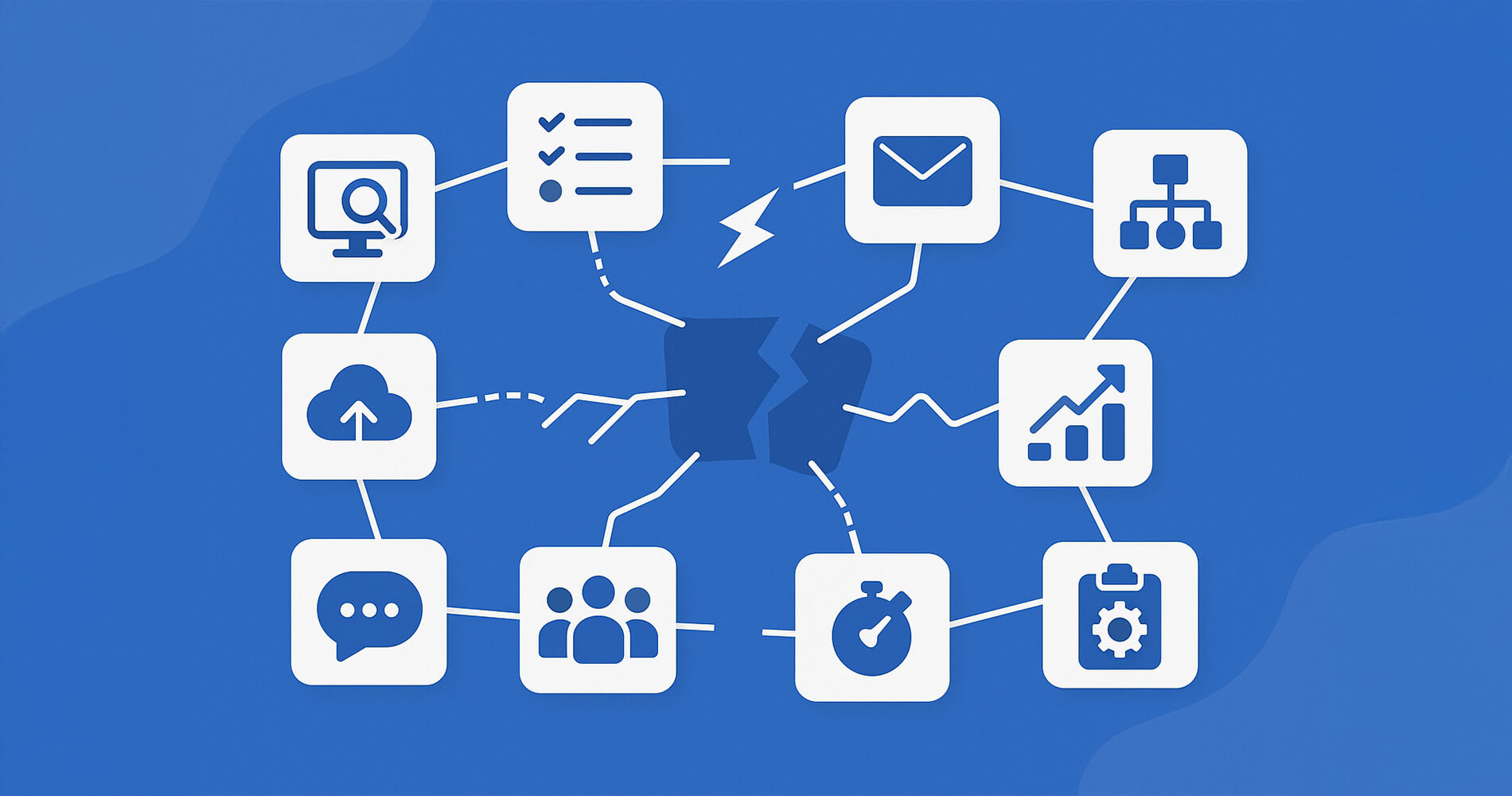6 MIN READ
The Hidden Cost of Disconnected Tools and How to Fix It
Connect the Dots to Unlock the Full Potential of Your Tools
Namita Awasthi | June 18, 2025

Imagine you’re a project manager in a fast-paced enterprise, preparing for a crucial client meeting. You need up-to-date sales data, internal notes on the client, the latest support ticket history, and project documentation. You open Salesforce for sales data, Slack for team communication, Zendesk for support tickets, Google Drive for shared proposals, and Confluence for internal documentation. Each of these tools is excellent on its own, but accessing all of them takes time - an average of 20 to 30 minutes just to pull the relevant information together.
This process, though seemingly efficient, is far from it. By the time you’ve gathered everything, that precious time could have been spent refining your pitch or engaging more deeply with the client. Multiply this by multiple teams across different departments, and the hidden costs of using disconnected tools quickly add up - time wasted, productivity lost, and collaboration hindered.
This process, though seemingly efficient, is far from it. By the time you’ve gathered everything, that precious time could have been spent refining your pitch or engaging more deeply with the client. Multiply this by multiple teams across different departments, and the hidden costs of using disconnected tools quickly add up - time wasted, productivity lost, and collaboration hindered.
The True Cost of Disconnected Tools
In today’s enterprises, teams rely on a wide variety of tools to get their work done. Salesforce, HubSpot, or Zoho handle customer relationships; Slack, Microsoft Teams, or Google Chat facilitate communication; Jira, Asana, or Basecamp track projects; Zendesk, Freshdesk, or ServiceNow manage support tickets; Workday, BambooHR, or SAP SuccessFactors streamline HR processes; Confluence, Notion, or SharePoint house knowledge and documents. While each of these platforms excels at solving specific problems, they create a fragmented ecosystem that silently undermines productivity.
When employees need to access information across multiple platforms just to get a full view of a customer, employee, or project, valuable time is wasted. Important insights are buried across silos. Teams spend hours searching, syncing, and repeating efforts. This hidden friction is one of the biggest and most underestimated costs in modern enterprises.
When employees need to access information across multiple platforms just to get a full view of a customer, employee, or project, valuable time is wasted. Important insights are buried across silos. Teams spend hours searching, syncing, and repeating efforts. This hidden friction is one of the biggest and most underestimated costs in modern enterprises.
Disconnected Tools = Disconnected Workflows
The average knowledge worker juggles between 6 to 10 apps daily. Yet, 70% of them report spending too much time hunting for the information they need to do their jobs. The result? Slower work, fragmented collaboration, and decisions based on incomplete or outdated data.
Take marketing and sales teams, for example. Marketing often needs access to customer insights stored in Salesforce, but without the right permissions, they are left guessing. Even though they may only need to view a few dashboards, the lack of visibility creates friction, leading to wasted effort, duplicated work, and missed opportunities. The impact isn’t just financial. Misalignment between teams can directly harm customer relationships and business outcomes.
The cost of these inefficiencies isn’t always visible at first, but over time, it erodes the organization’s productivity and stifles growth.
Take marketing and sales teams, for example. Marketing often needs access to customer insights stored in Salesforce, but without the right permissions, they are left guessing. Even though they may only need to view a few dashboards, the lack of visibility creates friction, leading to wasted effort, duplicated work, and missed opportunities. The impact isn’t just financial. Misalignment between teams can directly harm customer relationships and business outcomes.
The cost of these inefficiencies isn’t always visible at first, but over time, it erodes the organization’s productivity and stifles growth.
Information Silos Pose Real Business Risks
Disconnected tools not only harm productivity, but they also introduce serious operational risks:
- Slower Decisions: Leaders lack a consolidated view of critical business data, making it harder to act quickly and confidently.
- Inconsistent Data: Different teams may rely on different versions of the same data, leading to misalignment and rework.
- Lost Knowledge: Contextual information is often siloed within individual platforms, making it hard to find and easy to lose.
- Frustrated Teams: When employees can’t access the information they need, frustration grows and output slows.
Buying more software or increasing licenses rarely solves the core issue. More tools often mean more complexity, instead of clarity. It’s like adding more pieces to a puzzle without the proper picture to guide you.
Why More Tools Aren’t the Answer
When organizations realize their existing tools aren’t integrated, they often buy more software, hoping to streamline operations. But without proper integration, these tools only add to the noise. Moreover, cost constraints usually limit access to specific teams or roles. Data remains locked behind paywalls, out of reach for the people who need it most.
Consider the example of a sales manager needing to access marketing materials or a support team member needing to quickly pull up the latest customer feedback. Without seamless access to the right tools, they’re forced to waste time tracking down information from various sources, leading to delays and missed opportunities.
Consider the example of a sales manager needing to access marketing materials or a support team member needing to quickly pull up the latest customer feedback. Without seamless access to the right tools, they’re forced to waste time tracking down information from various sources, leading to delays and missed opportunities.
The Shift: From App Access to Information Context
What if your teams didn’t need access to every tool but just the right context from those tools?
This is where ContextSpace steps in. Instead of focusing on giving everyone access to every platform, ContextSpace helps create a unified layer of context around key business entities such as customers, employees, projects, products or any other entity that is relevant at that moment. By integrating with your existing tools, ContextSpace pulls relevant data and presents it in a unified, easy-to-navigate space. This allows teams to get the full picture without constantly switching apps or requesting logins.
This is where ContextSpace steps in. Instead of focusing on giving everyone access to every platform, ContextSpace helps create a unified layer of context around key business entities such as customers, employees, projects, products or any other entity that is relevant at that moment. By integrating with your existing tools, ContextSpace pulls relevant data and presents it in a unified, easy-to-navigate space. This allows teams to get the full picture without constantly switching apps or requesting logins.
What ContextSpace Delivers
- Eliminate Silos
Integrate and connect data from CRMs, task managers, communication tools, HR platforms, and more. Turn your digital workplace into a cohesive, streamlined environment. - Reduce Costs
Avoid the need for extra software licenses to grant visibility. ContextSpace provides the insights your teams need without granting full platform access, saving your IT budget. - Boost Productivity
Give employees self-serve access to the context they need. No more wasting time searching for information or waiting for other teams to update them. - Enhance Collaboration
When everyone can see the same data, collaboration becomes faster and more effective. Teams align quickly, share insights easily, and work toward common goals with fewer blockers.
A More Connected Digital Workplace
True enterprise productivity doesn’t come from using more tools; it comes from using them better. When systems are connected intelligently, your teams can access the right information in the right context. The result? More time spent on high-value work, and less time navigating the maze of disconnected tools.
The hidden cost of disconnected tools is real, but it’s avoidable. By prioritizing the flow of information over platform access, your organization can reclaim the time, clarity, and momentum.
Ready to unlock your enterprise’s full productivity potential? Let’s talk about how ContextSpace can simplify your information landscape.
The hidden cost of disconnected tools is real, but it’s avoidable. By prioritizing the flow of information over platform access, your organization can reclaim the time, clarity, and momentum.
Ready to unlock your enterprise’s full productivity potential? Let’s talk about how ContextSpace can simplify your information landscape.

Namita Awasthi
A driving force behind ContextSpace, Namita led the ideation and development of the platform, turning bold ideas into a practical solution that helps teams streamline work, surface insights, and scale productivity.






